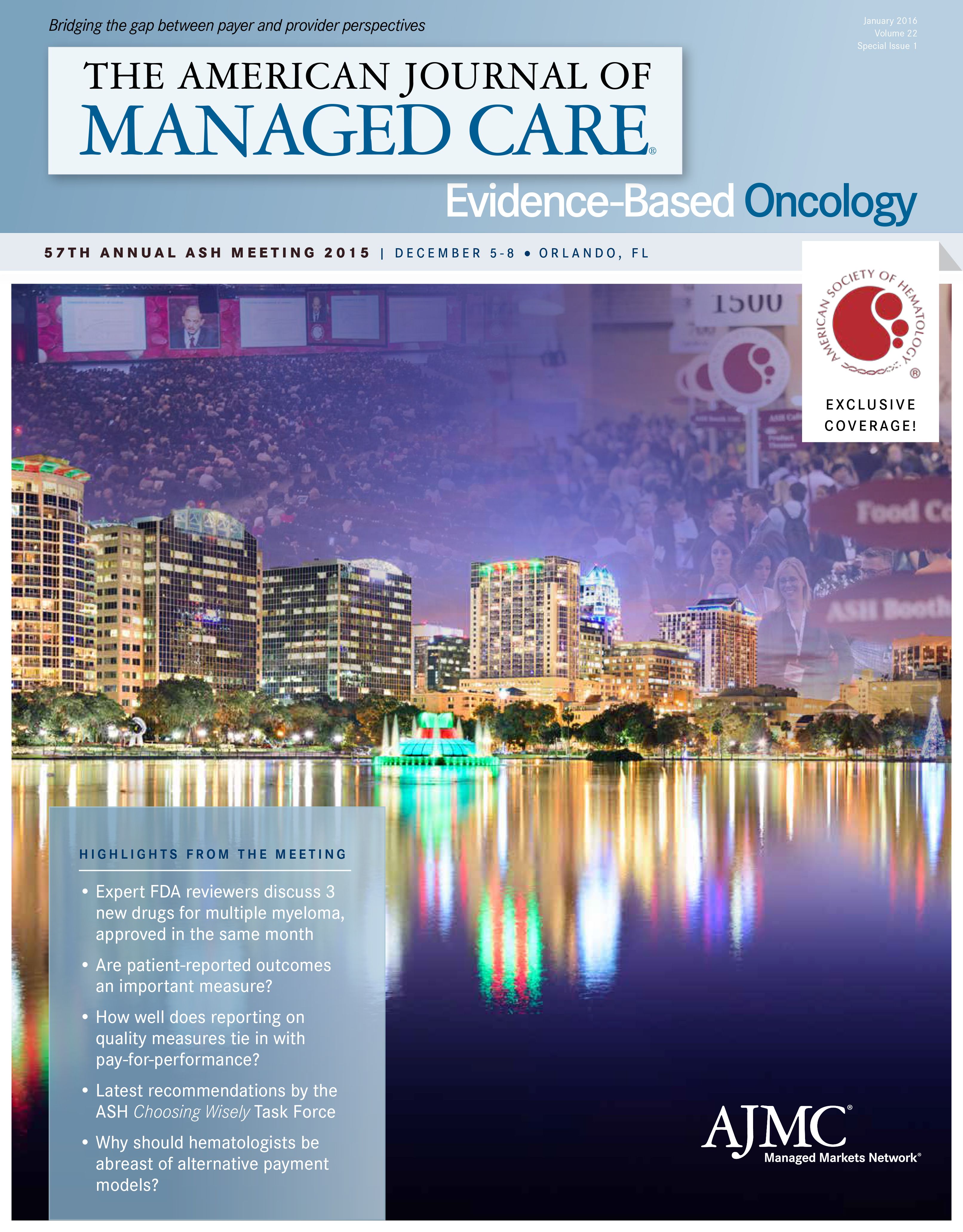Publication
Article
Evidence-Based Oncology
Importance of Patient-Reported Outcomes and Quality-of-Life Measures in Myeloid Disease
Author(s):
Results from a patient-reported outcomes measure of symptoms and symptom burden, experienced by patients with acute myeloid leukemia and myelodysplastic syndrome, were presented at the 57th annual meeting of the American Society of Hematology.
Patients’ assessment of their disease and treatment symptoms can significantly impact outcomes, potentially due to adherence issues. To date, adequately validated measures for patient-reported disease and treatment-related symptom burden in acute myeloid leukemia (AML) and myelodysplastic syndrome (MDS) are scarce. Identifying this gap, scientists at MD Anderson Cancer Center developed a short, valid, reliable patient-reported outcomes measure (PROM) of symptoms and symptom burden experienced by patients with AML and patients with MDS. The results from this study were consolidated in a poster that was presented at the annual meeting of the American Society of Hematology.1
A total of 152 patients with AML and 97 patients with MDS recruited to this study twice rated the 13 core symptom items (pain, fatigue, nausea, disturbed sleep, distress, shortness of breath, trouble remembering, lack of appetite, drowsiness, dry mouth, sadness, vomiting, and numbness and tingling), 6 proposed AML/MDS symptom items (muscle weakness, malaise, fever, headache, diarrhea, skin problems), and 6 interference items (general activities, mood, work, relations with others, walking, and enjoyment of life) on a 0-to-10 scale (0 = not present or no interference; 10 = as bad as can be imagined or complete interference), 1 to 2 days apart. Patient clinical and demographic information was collected from medical records and analyzed using descriptive statistics.
The study found that both groups of patients endorsed similar symptoms and the means of the 4 final AML/MDS symptoms were not significantly different between the groups, which led the authors to conclude that the lack of symptom recognition by patients with AML or MDS can lead to inadequate symptom management, interfere with patient ability to function and enjoy life, and impact the tolerability of and adherence to treatment regimens. The authors feel that their questionnaire, a PROM, is sensitive because it could recognize significant differences in symptom severity between AML inpatients and MDS outpatients.
Lead author Loretta A. Williams, PhD, RN, MSN, assistant professor in the Department of Symptom Research at MD Anderson Cancer Center, told Evidence- Based Oncology, “We were not sure that a single instrument would be appropriate for both AML and MDS. We were glad that while the instrument is sensitive to differences in severity of symptom burden between the 2 diseases, the same set of symptoms was appropriate for both.” She sees potential for this PROM to be used by pharmaceutical companies in clinical trials of leukemia therapy because it was developed using the FDA guidance for patient-reported outcomes for labeling indications.
Some of the treatments used in patients with AML and MDS—many of whom are in their 60s and 70s—are harsh, and choosing these treatments for older patients can be a difficult decision, considering their impact on the patient’s quality of life (QoL). In the absence of curative treatment, improving the patient’s QoL holds importance. With this objective, researchers from the Moffitt Cancer Center compared QoL between groups receiving intensive therapy, nonintensive therapy, and supportive care, the results of which were also presented in the same session as the first study.2
Eighty-five patients diagnosed with high-risk MDS or AML, 60 years and older, were recruited at Moffitt Cancer Center between December 2013 and April 2015. Forty-six patients received intensive therapy, 34 received nonintensive therapy, and 5 received supportive therapy. The outcomes measure for QoL, Functional Assessment of Cancer Therapy-Leukemia (FACT-Leu), established the following goals:
- Compare the difference in QoL scores measured by the FACT-Leu version for intensive chemotherapy, nonintensive therapy, and supportive care within 7 days of new treatment or the decision to pursue supportive care 1 month or later.
- Determine QoL predictors of AML and high risk MDS from age, comorbidity, fatigue, and diagnosis.
- Test the moderating effect of treatment with age, comorbidity, and fatigue on QoL.
The authors observed that the intensive- treatment group had significant improvements in their QoL scores at 1 month post treatment (P = .04). Considering the predictors of QoL, a significantly negative correlation was recorded between fatigue and QoL (r = -0.693, P <.001), indicating that QoL decreased with an increase in fatigue. However, the QoL scores for age, comorbidity, and fatigue were not moderated by treatment.
The authors concluded that the most intensive treatment improved QoL scores at 1 month and that fatigue is a significant predictor of QoL in this patient population. They suggest further studies with a larger, more diverse sample to explore the relationship between treatment approaches and QoL, in addition to intervention studies in AML and high risk MDS that would emphasize fatigue management.
EBO
REFERENCES
1. Williams LA, Garcia-Gonzalez A, Ahaneku HO, et al. A patient-reported outcome measure for symptoms and symptom burden of acute myeloid leukemia (AML) and myelodysplastic syndrome
(MDS). American Society of Hematology website. https://ash.confex.com/ash/2015/webprogram/Paper81364.html. Accessed December 18, 2015.
2. Tinsley SM, Small BJ, Lancet JE, et al. What is the impact on quality of life of various treatments in acute myeloid leukemia and high-risk myelodysplastic syndrome? Rethinking the goals. American Society of Hematology website. https://ash.confex.com/ash/2015/webprogram/Paper81364.html. Accessed December 18, 2015.
Lead study author Sara M. Tinsley, PhD, ARNP, AOCN, from the Moffitt Cancer Center, wrote in an e-mail to Evidence-Based Oncology, “In our practice at Moffitt, we discuss various treatment options and their most common side effects, with very limited QoL data to guide our discussions. We discuss riskto- benefit ratio, with the risk of death from treatment and the benefit of prolonged survival. From our preliminary findings, we can also inform patients that treatment with intensive treatment can improve their QoL at 1 month post treatment.” Tinsley hopes that the findings of their study will inform decision making and lead to more longitudinal evaluation of QoL in patients with high-risk MDS and AML.





